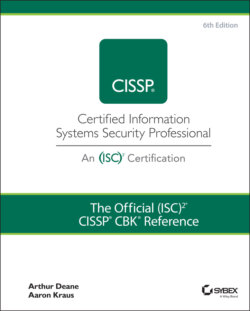Читать книгу The Official (ISC)2 CISSP CBK Reference - Leslie Fife, Aaron Kraus - Страница 104
Business Impact Analysis
ОглавлениеAccording to the ISO, a business impact analysis is “the process of analyzing the impact over time of a disruption on the organization.” In other words, a BIA helps an organization identify its essential business functions and understand the impact that a disaster would have on each of those functions; the BIA provides the primary justification for the business continuity plan and its requirements. The BIA helps an organization identify which of its business functions are more resilient and which are more fragile.
To complete the BIA, you should begin by establishing your BC project team, scope, and budget; we cover this step in the next section, “Develop and Document the Scope and the Plan.” You should ensure that you have executive support for BCP activities. BCP does not yield an immediate or tangible return, so you need senior leadership's support for financial resources, staffing, and overall strategic vision.
The next step is one of the most important: identify all your critical business functions (CBFs) and other essential business elements. The key word here is business, as you should be focused on identifying the essential functions that are critical to your business operations, whether your business involves selling widgets or saving lives.
Identifying CBFs requires input from a broad range of stakeholders. The perspectives of the system owners, subject-matter experts, customers, and suppliers all help in identifying an organization's potential CBFs. A list of CBFs and essential business elements should include the following:
Personnel
Business processes
Information systems and applications
Other assets
For each CBF that your organization identifies, you should perform a risk analysis to identify any vulnerabilities that exist, along with steps to mitigate those weaknesses. In addition, you must determine the likelihood of adverse events affecting your CBFs and the level of impact the business is willing to accept due to disruption to any one of the critical business functions. Determining the level of impact of a disaster is done in several ways, and there are a few metrics that you should be comfortable with:
Maximum tolerable downtime (MTD), or maximum acceptable outage (MAO), expresses the total length of time a critical business function can be unavailable without causing significant, long-term harm to the business; it is the longest time a CBF can remain disabled before it threatens the organization's long-term survival. MTD must be defined by the system owner, who is ultimately responsible to the organization for the proper operation of the CBF. Exceeding the MTD is an expression of unacceptable risk by the business owner.
Recovery time objective (RTO) is the planned time necessary to restore a system to the point where it meets the minimum service expectations of the system owner. In other words, RTO is the maximum period of time within which a CBF must be restored after a disruption to avoid unacceptable business consequences. Since unacceptable disaster occurs when the MTD is exceeded, the RTO, by definition, must be less than or equal to the MTD. The RTO must be adjusted by the application of additional controls to bring it within the MTD. At the point where the business owner is no longer willing to apply control, they have accepted the risk of operation.
Recovery Point Objective (RPO) represents the measurement of tolerable data loss, represented as a period of time. As with the MTD, this must be defined by the business, and the business is responsible for resourcing the controls to achieve the RPO.
MTD, RTO, and RPO are essential thresholds for business continuity planning. Figure 1.4 visually represents these concepts and how they fit together.
FIGURE 1.4 Relationship between MTD, RTO, and RPO
NOTE MTD, RTO, and RPO are important planning horizons and estimates that are strongly linked to an organization's risk tolerance. During an actual recovery event, organizational leaders can and usually do adapt in real time, making these thresholds more guidelines than strict survival limits.
